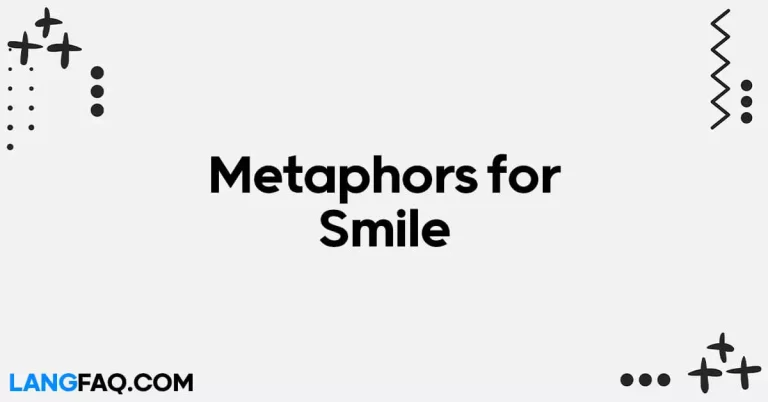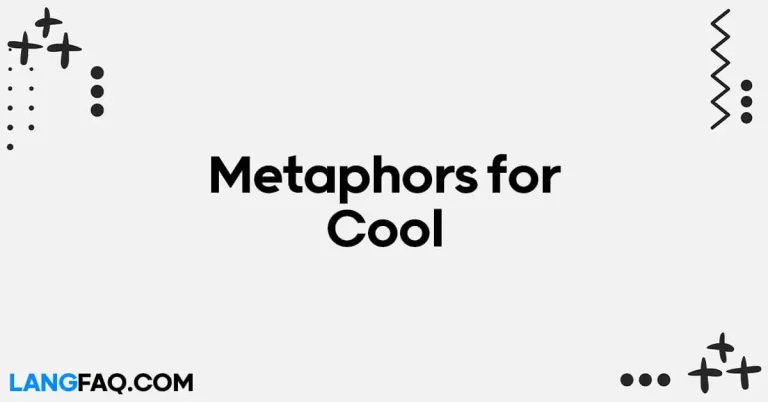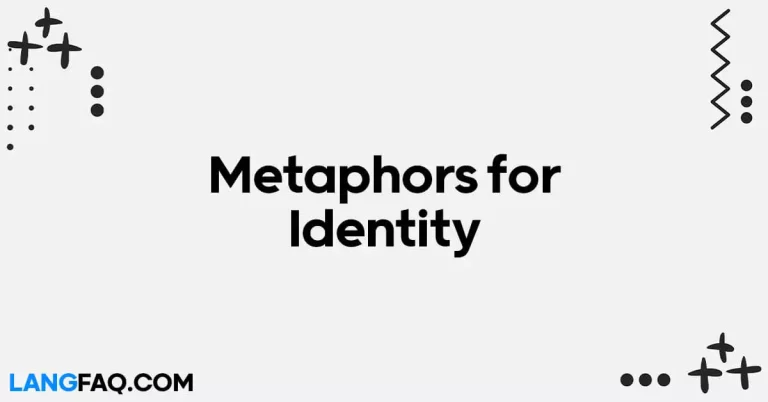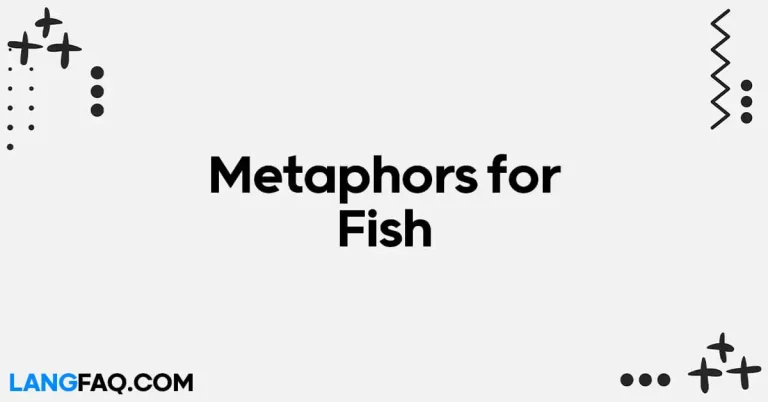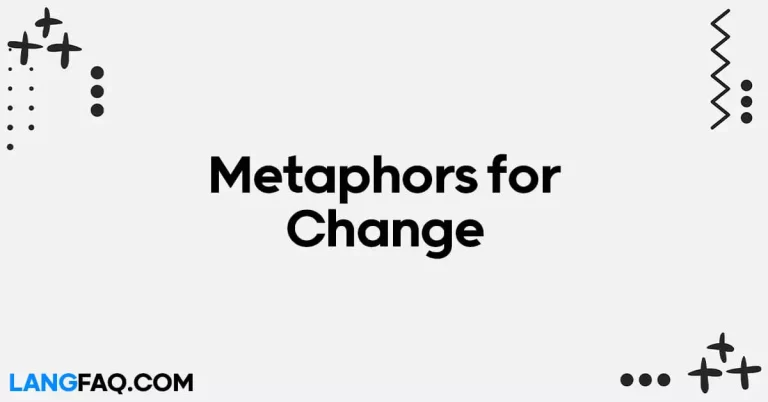Addiction, a labyrinth of emotions and struggles, is often challenging to articulate. In this exploration, we delve into 26 metaphors, each unraveling a different facet of the intricate web that is addiction.
26 Metaphors for Addiction
- The Journey Metaphor: Addiction is like embarking on an arduous life journey, complete with challenges, unexpected turns, and the constant struggle to find the right path.
- The Prison Metaphor: Individuals entrapped by addiction can feel like prisoners, confined by the bars of substance dependence, seeking liberation.
- The Puppet Metaphor: Addiction pulls the strings, turning individuals into puppets, illustrating the loss of control and autonomy in the face of dependency.
- The Shadow Metaphor: Addiction lurks in the shadows, influencing thoughts and actions, representing the hidden and pervasive nature of the struggle.
- The Storm Metaphor: Addiction is a tempest, sweeping individuals into chaos, symbolizing the turbulent and destructive nature of addictive behaviors.
- The Comfort Zone Metaphor: Addiction becomes a misguided comfort zone, offering a false sense of solace, leading individuals astray.
- The Monster Metaphor: Personifying addiction as a monstrous force, this metaphor explores the terror it instills and the battles faced against this formidable foe.
- The Dance Metaphor: Addiction is like a dance, with intricate steps and missteps, representing the rhythm and struggle to break free from its relentless choreography.
- The Maze Metaphor: Lost in the complexities of addiction, individuals navigate a maze with no clear exit, symbolizing the challenges of finding a way through.
- The Vampire Metaphor: Addiction, like a metaphorical vampire, drains life energy, illustrating the consuming nature of addictive behaviors.
- The Weight Metaphor: Addiction imposes a heavy burden, both tangible and intangible, symbolizing the weight carried by those in its grasp.
- The Circus Metaphor: Addiction is a spectacle, an ongoing circus of highs and lows, representing the theatrical nature of the struggle.
- The Broken Record Metaphor: Addiction repeats destructive patterns, becoming a broken record, illustrating the cyclical nature of addictive behaviors.
- The Prisoner Metaphor: Captivity defines addiction, with individuals feeling like prisoners bound by the chains of substance dependence.
- The Wildfire Metaphor: Addiction spreads uncontrollably like a wildfire, leaving destruction in its wake and illustrating its pervasive nature.
- The Puppeteer Metaphor: External influences act as puppeteers, pulling the strings in the intricate dance of addiction, manipulating behavior.
- The Quicksand Metaphor: Gradually sinking into the depths of addiction, the quicksand metaphor depicts the slow descent into the clutches of substance dependence.
- The Isolation Metaphor: Addiction brings feelings of loneliness and disconnection, portrayed through the metaphor of isolation.
- The Dark Tunnel Metaphor: Addiction is like a dark tunnel, seemingly endless, representing the struggles of finding a way out.
- The Broken Vessel Metaphor: Fragility and damage characterize the broken vessel metaphor, illustrating the impact of addiction on one’s well-being.
- The Poison Metaphor: The toxic nature of addictive behaviors is explored through the poison metaphor, highlighting the harm inflicted and the need for detoxification.
- The Phoenix Metaphor: Rising from the ashes of addiction, the phoenix metaphor offers hope and symbolizes the journey of transformation and rebirth.
- The Siren Song Metaphor: Addiction’s allure is compared to the enchanting song of sirens, enticing individuals into its dangerous embrace.
- The Web Metaphor: Addiction weaves a complex web, entangling individuals in its intricacies and making escape a challenging endeavor.
- The Shadow Puppet Metaphor: Addiction manipulates individuals like shadow puppets, casting them into roles dictated by its influence.
- The Labyrinth Metaphor: Addiction is a labyrinth, with twists and turns that make it difficult for individuals to find their way to recovery.
These metaphors offer diverse perspectives on the complex and multifaceted nature of addiction.
| Metaphor | Meaning | Example |
|---|---|---|
| The Journey Metaphor | Addiction as a challenging life journey, complete with obstacles and unexpected turns. | Navigating addiction is akin to traversing a difficult and uncertain path. |
| The Prison Metaphor | Individuals feel confined by the bars of substance dependence, seeking liberation from addiction. | Addiction can imprison people, making them yearn for freedom. |
| The Puppet Metaphor | Addiction pulls the strings, turning individuals into puppets, symbolizing loss of control. | In addiction, one often feels like a puppet, controlled by substances. |
| The Shadow Metaphor | Addiction lurks in the shadows, influencing thoughts and actions, representing hidden struggles. | The shadow of addiction follows, impacting every aspect of life. |
| The Storm Metaphor | Addiction is a tempest, sweeping individuals into chaos, illustrating the destructive nature. | The storm of addiction leaves destruction in its wake. |
| The Comfort Zone Metaphor | Addiction becomes a misguided comfort zone, offering false solace and leading individuals astray. | The allure of the comfort zone in addiction can be deceptive. |
| The Monster Metaphor | Personifying addiction as a monstrous force, exploring the terror it instills and battles faced. | Confronting addiction often feels like battling a formidable monster. |
| The Dance Metaphor | Addiction is like a dance, with intricate steps and missteps, representing the rhythm and struggle. | The dance of addiction involves intricate steps and constant struggle. |
| The Maze Metaphor | Addiction creates a maze, where individuals feel lost and struggle to find a way out. | Navigating addiction can feel like being trapped in an endless maze. |
| The Vampire Metaphor | Addiction, like a vampire, drains life energy, depicting the consuming nature of addictive behaviors. | Addiction sucks the life out of individuals, leaving them drained. |
| The Weight Metaphor | Addiction imposes a heavy burden, both tangible and intangible, symbolizing the weight carried. | The weight of addiction can be overwhelming, affecting every aspect of life. |
| The Circus Metaphor | Addiction is a spectacle, an ongoing circus of highs and lows, representing the theatrical struggle. | Living with addiction is like being part of a never-ending circus. |
| The Broken Record Metaphor | Addiction repeats destructive patterns, becoming a broken record, illustrating cyclical behaviors. | In addiction, individuals often find themselves stuck on a broken record. |
| The Prisoner Metaphor | Captivity defines addiction, with individuals feeling like prisoners, bound by substance dependence. | Addiction can make individuals feel imprisoned, yearning for freedom. |
| The Wildfire Metaphor | Addiction spreads uncontrollably like a wildfire, leaving destruction in its pervasive wake. | The wildfire of addiction consumes everything in its path. |
| The Puppeteer Metaphor | External influences act as puppeteers, pulling the strings in the dance of addiction, manipulating behavior. | Addiction can feel like being controlled by external forces. |
| The Quicksand Metaphor | Gradually sinking into the depths of addiction, the quicksand metaphor depicts the slow descent. | Addiction can feel like sinking into quicksand, a slow and relentless descent. |
| The Isolation Metaphor | Feelings of loneliness and disconnection portrayed through the isolation metaphor in addiction. | Addiction often brings a sense of isolation and disconnection from others. |
| The Dark Tunnel Metaphor | Addiction is like a dark tunnel, seemingly endless, symbolizing the struggles of finding a way out. | In addiction, individuals may feel trapped in a dark and seemingly endless tunnel. |
| The Broken Vessel Metaphor | Fragility and damage characterize the broken vessel metaphor, illustrating the impact on well-being. | Addiction can leave individuals feeling like broken vessels, fragile and damaged. |
| The Poison Metaphor | The toxic nature of addictive behaviors is explored through the poison metaphor, highlighting harm. | Addictive behaviors act like a poison, causing harm to both physical and mental well-being. |
| The Phoenix Metaphor | Rising from the ashes of addiction, the phoenix metaphor offers hope and symbolizes transformation. | Recovery from addiction is like the phoenix rising from the ashes—a journey of transformation. |
| The Siren Song Metaphor | Addiction’s allure is compared to the enchanting song of sirens, enticing individuals into its dangerous embrace. | The allure of addiction can be as captivating and dangerous as the song of sirens. |
| The Web Metaphor | Addiction weaves a complex web, entangling individuals and making escape from its intricacies challenging. | The web of addiction can be intricate and challenging to break free from. |
| The Shadow Puppet Metaphor | Addiction manipulates individuals like shadow puppets, casting them into roles dictated by its influence. | Addiction can make individuals feel like they are being manipulated, their actions controlled by its influence. |
| The Labyrinth Metaphor | Addiction is a labyrinth, with twists and turns that make it difficult for individuals to find their way to recovery. | Navigating addiction is like trying to find a way through a labyrinth—full of twists and turns. |
These metaphors provide a vivid and diverse understanding of the complex nature of addiction.
The Journey: Navigating Life’s Challenges
In the realm of addiction, likening it to a journey provides a nuanced understanding. Much like life’s journey, addiction involves unexpected twists and turns, victories, and challenges. This metaphor emphasizes the dynamic nature of the struggle against addiction.
When to Use:
- Formal Context (Colleagues): “Navigating addiction is akin to traversing a difficult and uncertain path. Just as we strategize in our professional journeys, understanding the complexities of addiction requires a thoughtful approach.”
- Informal Context (Friends): “Hey, I’ve been thinking about addiction as a journey lately. Each step has its own challenges, right? It’s like we’re all on this unpredictable adventure together.”
Example Sentence:
“In our shared pursuit of understanding addiction, let’s acknowledge it as a journey, one where support and understanding can make all the difference.”
Tips:
- Reinforce the notion of progress in the journey to recovery.
- Encourage empathy and patience in supporting those dealing with addiction.
The Prison: Breaking Free from Dependency
Comparing addiction to a prison vividly illustrates the sense of confinement individuals may feel. It encapsulates the desire for liberation and emphasizes the struggle against the constraints of substance dependence.
When to Use:
- Formal Context (Mentor-Mentee): “In our journey towards professional growth, it’s crucial to recognize any ‘prisons’ that limit our potential. Just as breaking free from addiction requires introspection and determination, overcoming professional barriers demands self-awareness.”
- Informal Context (Friends): “Ever thought about addiction like being in a prison? Breaking free from it must be incredibly challenging. It got me thinking about the limitations we sometimes put on ourselves too.”
Example Sentence:
“Much like breaking free from the chains of addiction, liberating oneself from limiting beliefs is a transformative journey.”
Tips:
- Promote self-reflection for personal and professional growth.
- Encourage open conversations about perceived constraints.
The Puppet Strings: Regaining Control
The imagery of puppet strings symbolizes the loss of autonomy in addiction. This metaphor is powerful in conveying the struggle to regain control over one’s actions and decisions.
When to Use:
- Formal Context (Colleagues): “In the corporate world, the pressure to conform can sometimes feel like puppet strings. Understanding this dynamic is crucial for fostering a workplace that values individuality.”
- Informal Context (Friends): “I’ve been reading about addiction, and the puppet strings metaphor really hit me. It’s like sometimes life is pulling the strings, you know?”
Example Sentence:
“Breaking free from addiction often involves recognizing the puppet strings that dictate behavior and striving for autonomy.”
Tips:
- Advocate for individual agency in both personal and professional settings.
- Discuss strategies for regaining control over aspects of life.
The Shadow: Unveiling the Hidden Struggles
Portraying addiction as a shadow delves into the unseen and pervasive aspects of the struggle. It underscores the importance of acknowledging the hidden challenges individuals face.
When to Use:
- Formal Context (Mentor-Mentee): “In professional mentorship, recognizing the ‘shadows’ of challenges is crucial. Just as addiction has hidden facets, professional obstacles may not always be apparent at first glance.”
- Informal Context (Friends): “Have you ever felt like addiction is a shadow, always there but not always seen? It makes me think about the struggles we might not know about in each other’s lives.”
Example Sentence:
“Addressing addiction requires bringing the shadowy aspects of the struggle into the light, fostering understanding and support.”
Tips:
- Encourage open dialogue about hidden challenges in various contexts.
- Emphasize the importance of empathy and non-judgmental support.
The Storm: Turbulence in the Struggle
The storm metaphor vividly captures the chaotic and turbulent nature of addiction. It emphasizes the need for resilience and strength in facing the challenges posed by addictive behaviors.
When to Use:
- Formal Context (Colleagues): “Just as we weather storms in our professional lives, understanding the tempest of addiction is vital. Resilience is a shared trait that bridges both personal and professional challenges.”
- Informal Context (Friends): “Thinking about addiction as a storm makes me realize the strength needed to get through it. It’s like battling unpredictable weather, right?”
Example Sentence:
“Much like navigating a storm, individuals grappling with addiction require support and resilience to overcome the turbulence.”
Tips:
- Discuss strategies for building resilience in both personal and professional spheres.
- Foster a supportive environment that acknowledges the challenges individuals face.
The Comfort Zone: Illusion of Solace
Describing addiction as a misguided comfort zone emphasizes the deceptive allure of substances. It encourages introspection into the false sense of solace that addiction may provide.
When to Use:
- Formal Context (Mentor-Mentee): “Reflecting on our professional journeys, it’s essential to recognize when comfort zones become ‘misguided.’ Just as addiction offers false solace, staying within professional comfort zones may hinder growth.”
- Informal Context (Friends): “Have you ever thought about addiction as a misguided comfort zone? It’s like seeking solace in something that ultimately causes harm.”
Example Sentence:
“Understanding addiction involves acknowledging the allure of the misguided comfort zone and encouraging healthier coping mechanisms.”
Tips:
- Discuss the importance of stepping out of comfort zones for personal and professional growth.
- Encourage a culture of continuous learning and adaptability.
The Monster: Confronting the Formidable Foe
Personifying addiction as a monstrous force emphasizes the formidable nature of the struggle. This metaphor underscores the courage required to confront and overcome the challenges posed by addiction.
When to Use:
- Formal Context (Colleagues): “Much like facing professional challenges, confronting addiction is akin to battling a formidable monster. Both require resilience and a strategic approach.”
- Informal Context (Friends): “The monster metaphor for addiction got me thinking. It’s like facing this massive, scary thing. How do people find the strength to do that?”
Example Sentence:
“Confronting addiction is a courageous journey, akin to facing a formidable monster with determination and resilience.”
Tips:
- Foster discussions on courage and resilience in professional and personal contexts.
- Encourage strategies for facing challenges with strength and determination.
The Dance: Struggling with Intricate Steps
The metaphor of addiction as a dance captures the intricacy and struggle involved. It represents the rhythm of addictive behaviors and the ongoing effort to break free from their relentless choreography.
When to Use:
- Formal Context (Mentor-Mentee): “Navigating the intricacies of professional dynamics can feel like a dance. Similarly, understanding addiction as a dance sheds light on the complexities of the struggle.”
- Informal Context (Friends): “The dance metaphor for addiction is fascinating. It’s like trying to follow these intricate steps, and sometimes, you just want to break free.”
Example Sentence:
“Much like a dance, addiction involves intricate steps, and breaking free requires acknowledging the rhythm and finding a new path.”
Tips:
- Discuss the complexities of navigating professional relationships.
- Encourage open conversations about the challenges individuals face in breaking free from addictive behaviors.
The Maze: Navigating Complexity
Describing addiction as a maze emphasizes the intricate and challenging nature of finding a way out. This metaphor encourages exploration of the complexities individuals encounter on the path to recovery.
When to Use:
- Formal Context (Colleagues): “In our professional pursuits, navigating complexities can feel like traversing a maze. Similarly, understanding addiction as a maze highlights the challenges individuals face in finding a way out.”
- Informal Context (Friends): “Thinking of addiction as a maze makes me realize how tough it must be to find a way out. It’s like getting lost and trying to find your way back.”
Example Sentence:
“Addressing addiction involves acknowledging the maze of challenges and supporting individuals in finding their unique path to recovery.”
Tips:
- Encourage discussions on navigating complexities in both personal and professional spheres.
- Foster a supportive environment for individuals to share their unique journeys.
The Vampire: Draining Life Energy
The metaphor of addiction as a vampire illustrates the draining nature of addictive behaviors. It emphasizes the impact on one’s life energy and the need to break free from the consuming influence.
When to Use:
- Formal Context (Mentor-Mentee): “Much like professional challenges that can drain our energy, understanding addiction as a vampire sheds light on the consuming nature of the struggle.”
- Informal Context (Friends): “The vampire metaphor for addiction got me thinking. It’s like something draining your energy. How do people break free from that?”
Example Sentence:
“Overcoming addiction involves recognizing the draining impact, much like breaking free from the clutches of a metaphorical vampire.”
Tips:
- Discuss strategies for maintaining energy and well-being in professional and personal contexts.
- Encourage conversations about self-care and setting boundaries.
The Weight: Burden of Addiction
Describing addiction as a weight emphasizes the heavy burden, both tangible and intangible, that individuals carry. This metaphor encourages acknowledging the challenges and seeking support to lighten the load.
When to Use:
- Formal Context (Colleagues): “In our professional pursuits, acknowledging the weight of challenges is crucial. Similarly, understanding addiction as a weight emphasizes the burdens individuals carry and the need for support.”
- Informal Context (Friends): “The weight metaphor for addiction is powerful. It’s like carrying this heavy burden. How do people find the strength to lighten the load?”
Example Sentence:
“Addressing addiction involves recognizing the weight individuals carry and fostering a supportive environment to lighten the burden.”
Tips:
- Encourage discussions on acknowledging and addressing challenges in personal and professional spheres.
- Foster a culture of empathy and support.
The Circus: Theatrics of Addiction
Describing addiction as a circus highlights the ongoing spectacle of highs and lows. This metaphor emphasizes the theatrical nature of the struggle and the need for balance in navigating its dynamics.
When to Use:
- Formal Context (Mentor-Mentee): “In our professional journeys, balancing highs and lows is crucial. Similarly, understanding addiction as a circus sheds light on the theatrical nature of the struggle.”
- Informal Context (Friends): “Thinking of addiction as a circus is interesting. It’s like this ongoing spectacle. How do people find balance in that?”
Example Sentence:
“Navigating addiction involves recognizing the highs and lows of the circus and striving for balance in the midst of the theatrics.”
Tips:
- Discuss strategies for maintaining balance in personal and professional life.
- Encourage conversations about resilience and adaptability.
The Broken Record: Repetition of Destructive Patterns
The metaphor of addiction as a broken record illustrates the repetition of destructive patterns. It emphasizes the cyclical nature of addictive behaviors and the need to break free from the loop.
When to Use:
- Formal Context (Colleagues): “In our professional endeavors, breaking free from destructive patterns is crucial. Similarly, understanding addiction as a broken record sheds light on the repetitive nature of the struggle.”
- Informal Context (Friends): “The broken record metaphor for addiction resonates. It’s like being stuck in this loop. How do people find a way to break free?”
Example Sentence:
“Overcoming addiction involves recognizing the repetition of destructive patterns, much like breaking free from a metaphorical broken record.”
Tips:
- Encourage discussions on breaking free from negative patterns in personal and professional contexts.
- Foster a culture of continuous improvement and learning.
The Prisoner: Captivity of Addiction
Describing addiction as captivity emphasizes the sense of being imprisoned by substance dependence. This metaphor encourages acknowledging the constraints and striving for freedom.
When to Use:
- Formal Context (Mentor-Mentee): “Much like breaking free from professional constraints, understanding addiction as captivity sheds light on the struggle for freedom.”
- Informal Context (Friends): “The prisoner metaphor for addiction is intense. It’s like feeling trapped. How do people find the strength to break free?”
Example Sentence:
“Addressing addiction involves recognizing the sense of imprisonment and fostering a supportive environment to empower individuals to break free.”
Tips:
- Encourage discussions on breaking free from constraints in personal and professional spheres.
- Foster a culture of empowerment and self-determination.
The Wildfire: Uncontrollable Spread of Addiction
Describing addiction as a wildfire emphasizes its uncontrollable and destructive spread. This metaphor encourages understanding the pervasive nature of addictive behaviors and the need for intervention.
When to Use:
- Formal Context (Colleagues): “In our professional spheres, addressing issues before they escalate is crucial. Similarly, understanding addiction as a wildfire sheds light on the need for early intervention to curb its destructive spread.”
- Informal Context (Friends): “Thinking of addiction as a wildfire is intense. It spreads so quickly. How can people stop it?”
Example Sentence:
“Overcoming addiction involves acknowledging its wildfire-like nature and intervening early to prevent its destructive spread.”
Tips:
- Discuss strategies for early intervention and prevention in personal and professional contexts.
- Encourage a proactive approach to addressing challenges.
The Puppeteer: External Forces Controlling Behavior
The puppeteer metaphor emphasizes external influences as forces controlling behavior in the intricate dance of addiction. This metaphor encourages understanding the external factors at play and reclaiming autonomy.
When to Use:
- Formal Context (Mentor-Mentee): “In our professional journeys, recognizing external influences is crucial. Similarly, understanding addiction as a puppeteer sheds light on the intricate dance of external forces.”
- Informal Context (Friends): “The puppeteer metaphor for addiction is eye-opening. It’s like being controlled by external forces. How do people break free from that?”
Example Sentence:
“Breaking free from addiction involves recognizing the puppeteer-like external forces and striving for autonomy in the intricate dance of recovery.”
Tips:
- Encourage discussions on recognizing and mitigating external influences in personal and professional spheres.
- Foster a culture of autonomy and self-determination.
FAQs
How do metaphors help in understanding addiction? Metaphors serve as powerful tools to convey complex emotions and experiences associated with addiction. They provide a unique perspective that goes beyond traditional language, making it easier for individuals to grasp the nuances of this challenging journey.
Can metaphors be used in therapy for addiction? Absolutely. Metaphors offer therapists a creative and effective way to communicate with individuals struggling with addiction. They can aid in building rapport, fostering understanding, and facilitating discussions about the nature of addiction.
Are metaphors a form of self-expression in addiction recovery? Yes, individuals often use metaphors to express their feelings and experiences during the recovery process. Metaphors allow them to articulate the challenges, victories, and transformations they undergo, providing a rich narrative of their journey.
Do all metaphors for addiction have negative connotations? While many metaphors highlight the struggles and negative aspects of addiction, some, like the phoenix metaphor, emphasize resilience and positive transformation. Metaphors offer a diverse range of perspectives on the complex nature of addiction.
Can metaphors help reduce stigma around addiction? Certainly. Metaphors humanize the experience of addiction, making it relatable and understandable. By shifting the narrative from judgment to empathy, metaphors contribute to reducing stigma and fostering a more compassionate approach to addiction.
How can metaphors be integrated into everyday conversations about addiction? Incorporating metaphors into conversations about addiction requires sensitivity and context. Choose metaphors that resonate with the individual’s experiences and use them as bridges to discuss emotions, challenges, and the path to recovery.
Conclusion
In the tapestry of addiction, metaphors weave a narrative that goes beyond words. Each metaphor sheds light on a different facet, offering understanding, empathy, and hope. As we navigate these metaphors, may they serve as lanterns guiding individuals through the challenging journey of addiction.



